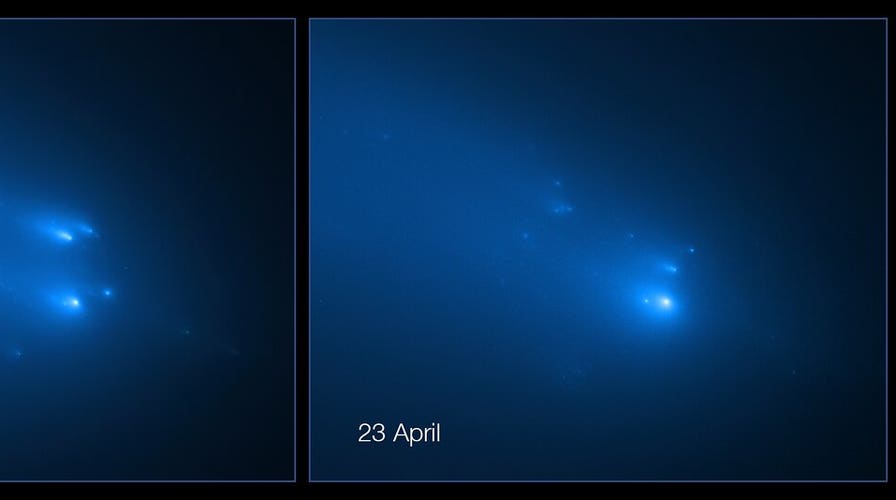Fox News Flash top headlines for April 30
Fox News Flash top headlines are here. Check out what's clicking on Foxnews.com.
NASA’s Hubble space telescope has captured incredible images of a comet’s disintegration.
Comet C/2019 Y4 (Atlas) was discovered in 2019 by the ATLAS (Asteroid Terrestrial-impact Last Alert System) robotic astronomical survey system in Hawaii, according to the European Space Center, which is NASA’s Hubble partner.
NASA’S HUBBLE TELESCOPE CELEBRATES 30 YEARS IN SPACE

The NASA/ESA Hubble Space Telescope captured images of the breakup of Comet C/2019 Y4 (ATLAS). (NASA, ESA, D. Jewitt (UCLA), Q. Ye [University of Maryland])
“It brightened quickly until mid-March, and some astronomers initially anticipated that it might be visible to the naked eye in May to become one of the most spectacular comets seen in the last two decades,” the ESA explained in a statement. “However, the comet abruptly began to get dimmer, leading astronomers to speculate that the icy core may be fragmenting, or even disintegrating.”
Hubble observed the comet’s breakup on April 20 and April 23.
'ZOMBIE SATELLITE' THAT HAS BEEN ORBITING EARTH SINCE 1967 DISCOVERED
![The comet's disintegration captured on April 20, 2020. (NASA, ESA, D. Jewitt (UCLA), Q. Ye [University of Maryland])](https://a57.foxnews.com/static.foxnews.com/foxnews.com/content/uploads/2020/04/1200/675/CometDisintegration2.jpg?ve=1&tl=1)
The comet's disintegration captured on April 20, 2020. (NASA, ESA, D. Jewitt (UCLA), Q. Ye [University of Maryland])
“Their appearance changes substantially between the two days, so much so that it's quite difficult to connect the dots,” said UCLA Professor David Jewitt, leader of one of two teams who imaged the comet with Hubble, in a statement. “I don’t know whether this is because the individual pieces are flashing on and off as they reflect sunlight, acting like twinkling lights on a Christmas tree, or because different fragments appear on different days.”
The comet was approximately 91 million miles from Earth when its disintegration was captured by Hubble, according to NASA’s Goddard Space Flight Center, which manages the telescope. “If any of it survives, the comet will make its closest approach to Earth on May 23 at a distance of about 72 million miles (116 million kilometers), and eight days later it will skirt past the Sun at 25 million miles (40 million kilometers),” it said in a statement.
CLICK HERE TO GET THE FOX NEWS APP
![The comet's disintegration captured on April 23, 2020. (NASA, ESA, D. Jewitt (UCLA), Q. Ye [University of Maryland])](https://a57.foxnews.com/static.foxnews.com/foxnews.com/content/uploads/2020/04/1200/675/CometDisintegration3.jpg?ve=1&tl=1)
The comet's disintegration captured on April 23, 2020. (NASA, ESA, D. Jewitt (UCLA), Q. Ye [University of Maryland])
Hubble, which was launched into orbit aboard the space shuttle Discovery April 24, 1990, recently celebrated 30 years in space. Over the course of three decades, the orbiting telescope has provided a wealth of discoveries.
Follow James Rogers on Twitter @jamesjrogers

